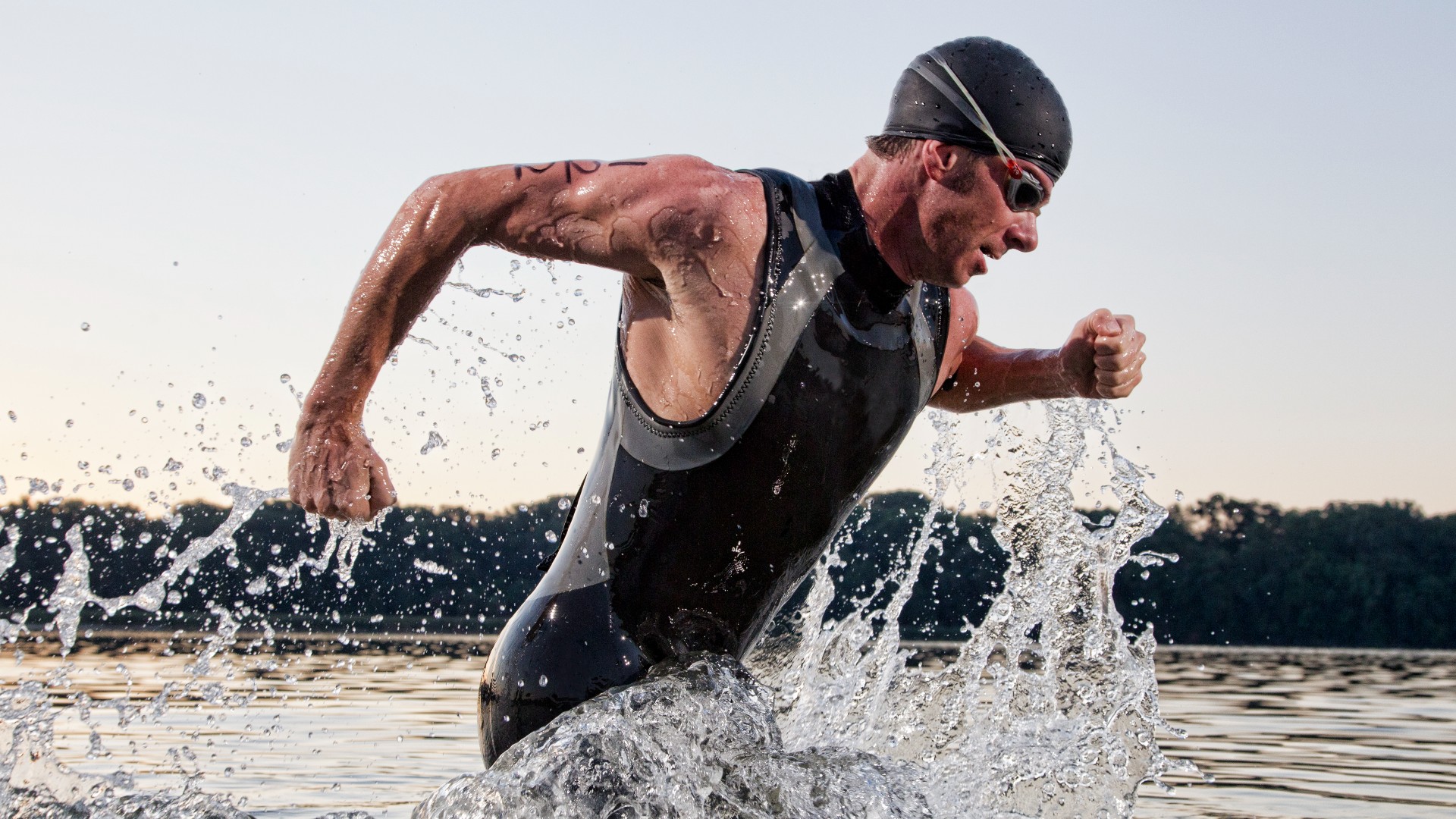Swimming vs running: Which is best for you?
As cardiovascular workouts, both offer clear benefits. But when it comes to swimming vs running, which is the right choice for you as an individual?

Swimming vs running is a debate that often has enthusiasts of both pursuits eagerly offering up advantages for their favored style of cardio, whether it’s hitting the pool or pounding away indoors on one of the best treadmills. Both are undoubtedly excellent ways to exercise, but when it comes to you as an individual, which one is the better choice?
You’ll be pleased to learn that both swimming and running come with plenty of health perks, but they do differ when it comes to the muscles they target, the mental health benefits they offer and the cost and practicality involved in choosing them as your preferred workout method.
Before you strap on your running shoes or go hunting for the best swim goggles, check out our breakdown of just what each workout offers you. That way, you can make the most informed choice possible and ensure that you’re making optimal gains from each and every calorie that you burn.
Comparing the burn
Speaking of burning, just how do the two pursuits measure up when it comes to calorie expenditure? According to Professor Tracey Devonport and Dr Ross Cloak from the Sport and Physical Research Centre at the University of Wolverhampton, U.K., this depends largely on how intensely you are able to perform in each discipline:
“If we look at the two activities, they are both excellent ways to burn calories,” says Cloak. “To crown a winner is difficult as the number of calories we use during exercise is based on several factors, including the intensity and duration of exercise. So, the answer is if you can only run for a small amount of time and at a very light intensity but find it easier to swim for a longer period, and at a higher intensity swimming may be a better option.”

Professor Tracey Devonport leads the Sport and Physical Activity Research Centre at the University of Wolverhampton. She is a registered sport and exercise psychologist with the Health Care Professions Council and accredited practitioner with the British Association of Sport and Exercise Sciences. She has provided consultancy services for more than 25 years, predominantly working with junior national athletes.
Of course, the opposite is true too, meaning you’ll burn more while running if you can hit a decent distance and maintain intensity. “Running is another excellent way to burn calories and keep fit and unlike swimming, you don’t need a pool, just a good pair of trainers and access to the outdoors,” notes Cloak. “The weight-bearing nature of running is an excellent activity for bone health.”
But what about the oft-quoted belief that the higher-impact nature of running can damage your joints? “Contrary to popular belief, running does not damage your knees,” argues Cloak. “Research has shown that runners are less likely to develop arthritis than non-runners and have a lower risk of osteoarthritis as they get older.”
Get the world’s most fascinating discoveries delivered straight to your inbox.
Engaging muscles
What if you are looking to strengthen particular areas or muscle groups though? Naturally, running largely only works the lower half of your body and Cloak is keen to point out that even then, regular engagement of those muscles should be complemented by resistance training to help them cope with the stress:
“These could be exercises that focus on the quads (squats/lunges), hamstrings (deadlifts), and calves (heel raises),” outlines Cloak. “All of these exercises will help improve your running and reduce your risk of injury. Unlike swimming, running can involve a lot more eccentric contractions of the muscle (lengthening of the muscle under tension) which can cause damage to the muscle. Not a bad thing and this will stimulate repair and better resilience in the muscle but may lead to a few days of muscle soreness and this needs to be considered when planning your training.”

Dr Ross Cloak is an associate professor in sport and exercise science at the University of Wolverhampton, where he splits his role between teaching, research, and knowledge exchange. He is an exercise physiologist who’s applied work has been conducted with professional football teams and endurance athletes and is currently a consultant physiologist to GB Judo. Ross is the CPD representative for the BASES performance sport division.
On the other hand, swimming recruits muscle groups from the entirety of your body, a clear advantage if you are looking for a more holistic workout that unlike running, engages the shoulders, chest and arms. The duo also note that should you be looking to strengthen a particular area, pool workouts can be modified to achieve this: “There are lots of ways you can focus on different body parts such as using floats, aqua belts, or trying different strokes which is an excellent way of changing up your training to keep things interesting,” Cloak explains. Additionally, some studies — such as this one from the Journal of Exercise Rehabilitation — also claim that for women, swimming can be useful in promoting flexibility and reducing blood lipid levels.
- Related: Why do muscles get sore after exercise?
- Related: Expert running tips from a sports scientist

Costs and practicality
In terms of expense, running will be a cheaper option. Unless you live near open water, swimming means the local gym or leisure center which incurs a regular cost. “Unlike swimming, you don’t need a pool, just a good pair of trainers and access to the outdoors,” adds Devonport. Just remember though, that good quality running shoes are important to prevent injury and as such, should figure into your budget.
As for practicality, running again offers the edge here. There’s nothing stopping most of us from starting a run the very moment we’ve warmed up and look to leave our doorstep, while a trip to the local pool involves travel time and associated costs. Still, the practical skills that come with regular swimming cannot be ignored: “One important benefit we must acknowledge with swimming is it is a lifesaving skill as well as a leisure pursuit,” outlines Devonport. “Raising awareness of the importance of basic swimming skills is an important issue.”
Benefits for your mental health
Again, both pursuits are great for your mental health and it comes down largely to your needs. The co-ordinated whole-body movement required when swimming is great for entering a state of ‘flow’, something that Devonport compares to practicing mindfulness. While running can offer a similar benefit, it also offers social advantages: “As with swimming, running on your own provides the space to think and process what is going on in your life,” explains Devonport.
“However, what running can offer over swimming is the potential for social benefits. While swimming, a conversation is difficult if not impossible to maintain with others, except for rest periods. When running with others, they can be a sounding board, to simply listen, perhaps offer advice or a different perspective. It is also worth remembering that mood is contagious, and by choosing to exercise with others who are in a good mood, you can help improve your own mood.”
It’s also worth noting that engaging in either exercise outdoors is preferable. Also, the mood benefits that come with either workout tend to follow a workout, rather than occurring at the time of training: “You may not necessarily feel mood benefits during exercise,” Devonport adds, “especially if the exercise is of a high intensity. Afterwards there is typically an improvement in mood and energy levels. This is linked to norepinephrine, dopamine, and serotonin which are all produced and released in higher concentrations during exercise, and all have been shown to help reduce depression.”

Final thoughts
As we mentioned at the beginning then, the ‘best’ choice is the one that works for you, when all of the factors above are taken into account. Remember though, maintaining intensity and duration are the key points to consider when looking to make the most gains, both physically and mentally. Finally, there’s no rule to say that you can’t do both as part of a balanced and effective workout regimen, with one study, published in the International Journal of Sports Medicine, finding that recovery swims are a great way of offsetting inflammation and enhancing subsequent runs.
Dan Cooper is an experienced fitness writer who firmly believes in the power of running. The hardest race he has completed so far was Tough Guy, the world’s oldest and most demanding OCR event. There he learned that you may be able to outpace opponents, but outrunning hypothermia? That's a different race entirely.



